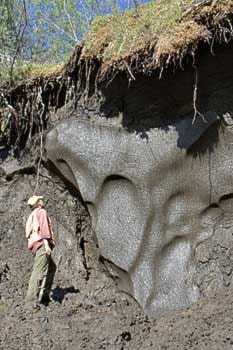The oldest-known ice on the continent has been discovered near Dawson City, producing evidence that climate change may not melt the icy corners of the world as quickly as some feared.
The chunk of ancient ice, dated to be about 750,000 years old, is testament, in the words of one scientist, to the “stubborn” character of permafrost — the frozen dirt that covers one quarter of the land in the northern hemisphere.
The speed that permafrost melts is of great concern because the frozen mud contains vast stores of carbon. If the world’s permafrost melted in coming decades, as some climate change models hold, that carbon may be released into the atmosphere as greenhouse gases, and exacerbate global warming.
But the ancient Yukon ice chunk suggests otherwise.
It appears to have survived two sweltering periods of the Earth’s history, through temperatures warmer than today.
“This isn’t saying we don’t need to worry about global warming,” said Duane Froese, an assistant professor from the University of Alberta and the lead researcher behind the discovery.
“This is just saying that the deep part of that equation, the deep permafrost, which has huge, huge stores of carbon, is probably stable, if we use the past response to climate as an idea as to what will happen in the future.”
It was previously believed all the patches of permafrost had melted in interior Alaska and Yukon during a warm patch about 120,000 years ago, said Froese.
The ice wedge indicates that is not the case.
On top of this, the ice would have also weathered another warm period, about 400,000 years ago.
The ice was found near Dominion Creek, about 30 kilometres southeast of Dawson City, during the summer of 2000. It forms a wedge within a crack in the permafrost, and is several metres beneath the surface.
The discovery would never had been made at all, said Froese, if not for placer mining activity in the area, which had eroded the side of a valley to expose the ice.
Ice is hard to date, so the significance of the discovery was not, at first, obvious. The clue that led to the ice’s age was a coating of volcanic ash atop the permafrost and ice. The ash must have fallen after the ice had formed, and it could be dated.
The discovery was finally made public prior to the publication of an article by Froese and his colleagues in the journal Science on Friday.
Some critics have suggested we should not read too much into Dawson’s ancient ice chunk. They say there is little reason to believe the rest of the world’s permafrost will behave in the same way. It may be an anomaly.
Exactly so, said Froese. The lesson to take away from his discovery is that permafrost is influenced by a whole range of factors other than temperature, he said. Cover offered by vegetation and soil, for example, may be “almost as important” as temperature.
Well-protected permafrost may survive further warming, but that “doesn’t mean we’re out of the woods for shallow permafrost,” said Froese.
Melting permafrost has already caused roads to buckle and buildings to sink into the tundra in parts of the world such as northern Quebec. But don’t expect permafrost to melt en masse, or in as dramatic a fashion as the enormous Arctic ice shelves shearing into the ocean, said Froese.
“Permafrost is different from that. Permafrost has resilience.”
